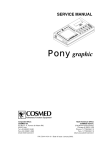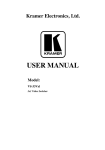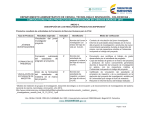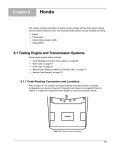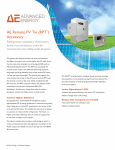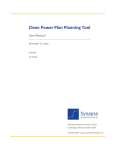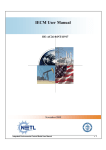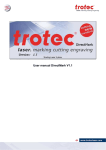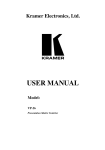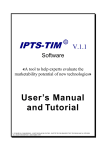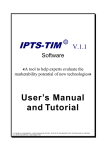Download Enter Main Title Here
Transcript
CCS FINANCIAL BLENDING MODEL DEVELOPED FOR THE STUDY “CARBON CAPTURE AND STORAGE IN DEVELOPING COUNTRIES: A PERSPECTIVE ON BARRIERS TO DEPLOYMENT” Sustainable Energy Department (SEG) & Banking and Debt Management (BDM) Disclaimers This CCS Model was developed to assess the impact of different financing structures (and other technical parameters) on the overall costs and revenues of power generation projects. Using a Levelized Cost of Electricity (LCOE) methodology, the model also estimates the impact of adding CCS related expenses and revenues on electricity rates. Under certain assumptions, the model can provide useful information to determine financial feasibility of a power plant that could be equipped with CCS facilities. As the model's output is dependent upon inputs and related assumptions provided by the user, careful judgment is required in interpreting the results. While the CCS model may be used as a quantitative tool in developing a borrowing strategy for a power generation project, any decisions on the specific borrowing strategy and its implementation should be undertaken after due consideration of all relevant factors specific to the country where the project is taking place, in conformity with all applicable laws and regulations and pursuant to all such authorizations as may be required. While every effort has been made to ensure complete accuracy, the World Bank does not accept responsibility for any errors in the CCS Model or for any errors that may result from using the CCS Model. In no event shall the World Bank or any of their staff or consultants be liable for any direct, indirect, punitive, incidental, special or consequential damages or any damages whatsoever including without limitation, damages for loss of use, data or profits, arising out of, or in any way connected with, the use of the CCS Model. For permission to photocopy or reprint any part of this work, please send a request to [email protected]. All rights reserved. ©2010 The International Bank for Reconstruction and Development / The World Bank 1818 H Street NW Washington DC 20433/ Telephone: 202-473-1000/ Internet: www.worldbank.org 2 Table of Contents 1. Overview of the study and of the technological and economic variables 2. The financial blending model developed by the World Bank 3. Working with the model: Hands-On 3 1. Overview of the study and of the technological and economic variables a. Executive Summary of the study b. Overview of the model: • Introduction • Technological Assumptions • Economic Assumptions 4 Overview of the study + technical inputs: a. Executive Summary of the study Background: Carbon Capture and Storage could have a significant impact as a carbon mitigation technology in Greenhouse Gas (GHG) emitting industries. Given the nascence of CCS technology, there are still significant challenges that must be overcome for large scale deployment, such as addressing technical issues of integration and scale up, legal and regulatory requirements to reduce investor risk, policies to mitigate economic impacts including increases in electricity prices, and financing mechanisms to facilitate investment in the technology use. The report addresses some of these barriers facing potential CCS deployment in developing countries. Taking into account this background, the study1: (a) assessed the economic and environmental (GHG) impacts of potential CCS deployment in power sectors in the Balkan and Southern Africa regions using a technoeconomic model; (b) analyzed legal and regulatory frameworks that could be applicable to potential CCS deployment in the Balkan and Southern Africa regions; (c) assessed the role of climate finance to support prospective investment needs for CCS project in developing countries; and Focus of this presentation (d) examined potential structures for financing power plants equipped with CCS and the impacts of CCS on the electricity rates through a levelized cost of electricity (LCOE) model. 1 The study can be found at http://go.worldbank.org/MJIX0TRAB0 5 Overview of the study + technical inputs: b. Overview of the model - Introduction The model was developed to investigate ways of structuring financing for power generation facilities equipped with CCS in developing countries, using instruments available from multilateral development banks and commercial financiers, as well as potential concessional funding sources. The model examines the impacts of CCS on electricity rates through a levelized cost of electricity (LCOE) model1, and included numerous variable parameters such as fuel prices (coal), Carbon credits prices (CO2e) and potential revenues from selling oil/gas obtained through enhanced hydrocarbon recovery (EOR). The objective was to developed a tool capable of assessing if different combinations of financial instruments and other variables mentioned above could result in reductions in the overall cost of financing, consequently requiring smaller incremental increases in electricity rates. 1 The Carbon Capture Storage Model (CCS Model) has been developed from the Spreadsheet that accompanies the paper: Du, Yangbo and John Parsons, 2009, "Update on the Cost of Nuclear Power", Center for Energy and Environmental Policy Research WP-09-004. 6 http://web.mit.edu/ceepr/www/publications/workingpapers/2009-004.pdf (For citations please also use the following link http://web.mit.edu/ceepr/www/publications/workingpapers/Du%20and%20Parsons%20update%20cost%20of%20nuclear%2009%2005%20rev2.xls)c Overview of the study + technical inputs: b. Overview of the model -Technological Assumptions (1/2) Technological assumptions1 The model was developed to include five generic coal technologies as reference plants with CCS2 and without CCS: Pulverized coal (PC) wet and dry-cooled Oxyfuel (Oxy) wet-cooled IGCC wet and dry-cooled Example of the Cost and Technical assumptions for Oxyfuel technologies in LCOE Model User could potentially change the type of plant as long as they enter all the parameters3 for the new technology in the Model. 1 2 3 For cost and technical assumptions for each technology see table 6.4., table 6.5., and table 6.6. in annex 6 of the “Carbon Capture and Storage in developing countries: A perspective on barriers to deployment “, The World Bank Paper. 7 The coal plants with CCS in the model allowed for both 25 percent CO 2 capture (described as partial capture), and 90 percent CO2 capture (described as full capture). All the Technical assumptions for the technologies are set up in the worksheet call “Tech & Economic Assumptions” of the CCS Model. Overview of the study + technical inputs: b. Overview of the model -Technological Assumptions (2/2) Technological assumptions For each technology, the LCOE was investigated for various circumstances, by varying the following parameters for several possible combinations: Coal prices: defined as low (US$1/MMBtu), medium (US$3/MMBtu) or high (US$5/MMBtu); Availability of extra revenues from enhanced hydrocarbon recovery (EOR/ECBM); Revenues from sale of Carbon Credits: Using CO2 prices at US$0, US$15, or US$50 per ton. Notes: See the “Carbon Capture and Storage in developing countries: A perspective on barriers to deployment “, The World Bank Paper. All the Technical assumptions are set up in the worksheet call “Tech & Economic Assumptions” of the CCS Model. 8 Overview of the study + technical inputs: b. Overview of the model - Economic Assumptions Economic assumptions Expected long term inflation in USD Is the average tax on profits for companies on developing countries where the Carbon Capture and Storage (CCS) Technology is more likely to take place Based on previous studies such as ESKOM Medupi Project, EPRI, Global CCS Institute, Worley Parsons, etc. Based on the average expected return on equity of energy generation gas and oil projects that use a “similar” technology in the last ten years, and also on some studies regarding this new CCS technology. Notes: All the Economic assumptions are set up in the worksheet call “Tech & Economic Assumptions” of the CCS Model. For more detailed explanation please go to “Carbon Capture and Storage in developing countries: A perspective on barriers to deployment “, The World Bank Paper. 9 2. The financial blending model developed by the World Bank a. Overview b. Financial Assumption: • Funding sources • Financial Structure c. Overview of the Worksheets d. Where to specify the model parameters e. How it works and Instructions f. Amount of variables the CCS model can handle at once 10 The financial blending model: a. Overview The model determines the Levelized Cost of Electricity (LCOE)1 by calculating the cash flows in every project year, and discounting these to the base year using the weighted average cost of capital (WACC). The WACC is a way of estimating the project specific discount rate and it is defined as follows: WACC = (Equity Return rate x [1- Debt fraction]) + (After Tax Average Debt rate x Debt fraction) Equity financing was capped at 35% of total required financing for each technology, and the expected rate of return on equity was 20% in all cases. With respect to the Debt Rate used in this study, different combinations of several funding sources were used. The model calculates the Internal Rate of Return (IRR) for each funding source based on their financial terms. By combining these funding sources an average debt rate can be calculated, which in turn determines the WACC. 11 1 See annex 1 for LCOE Structure The financial blending model: b. Financial Assumptions (1/4) a. Funding Sources1 (1/3) Different combinations of several funding sources were used. The model can have up to 6 different financing sources. Instruments available from multilateral development banks and commercial financiers , as well as concessional funding sources. The Model is in USD but it could be adapted to any currency as long as all the technical assumptions are expressed in the same currency. Notes: 1 Funding Sources can be changed in the “Funding Sources” worksheet. • Please be aware that this is an approximate figure used just for indicative purposes. This data is subject to continuous changes according to market references. For latest pricing information, regarding variable and fixed spread, please visit the Treasury website at http://treasury.worldbank.org. The variable spread is recalculated every January 1 and July 1. The model assumes the same variable spread over the life of the loan. 12 • All rates subject to change due to market conditions. • The guarantee used in this study assumes the characteristics of the Partial Credit Guarantee (PCG) instrument of the World Bank. The PCG covers debt service defaults on a portion of a loan or a bond, allowing public sector projects to access financing with extended maturities and/or lower spreads. The financial blending model: b. Financial Assumptions (2/4) a. Funding Sources (2/3) Maturity (years): Is the amount of time (years in this case) the loan will remain in existence until the debt is fully paid (30 years maximum final maturity including the grace period). Grace Period (years): This is the number of years during the life of the loan where there is no principal repayment. The first principal repayment would occur on the first payment date following the end of the grace period. Repayment Schedule: Borrowers have the flexibility to tailor the repayments by choosing any combination of grace period, final maturity. Bullet: Principal is paid in one lump sum at the term of the loan (at maturity). Level: Principal is paid in equal installments over time Bullet Level 110 10 90 Interest Payment 80 Principal Repayment 8 70 60 50 40 5 4 3 2 10 1 2 3 4 5 6 7 8 9 Years 10 11 12 13 14 15 16 17 18 Repayment of Principal 6 20 1 Grace Period 7 30 0 Interest Payment Principal Repayment 9 Millions of USD Millions of USD 100 0 1 2 3 4 5 6 7 8 9 10 11 12 13 14 15 16 17 18 19 20 21 22 23 24 25 26 27 28 29 30 Years Front-end Fee: Fee paid by the borrower to a lender or lead manager at the beginning of a loan. 13 The financial blending model: b. Financial Assumptions (3/4) a. Funding Sources (3/3) Lending Rate: 3 options Fixed Rate Loan: An interest rate that will remain the same rate for the entire term of the loan. Lending Rate = Swap Rate for the Average Maturity of the loan + Fixed Spread over LIBOR Variable Spread Loan and Fixed Spread Loan: An interest rate that moves up and down on the changes of an underlying interest rate. The variable spread loan lending rate is break down into: Lending Rate = Base Rate (6 month LIBOR1) + Spread over LIBOR The spread over LIBOR is an indication of the risk premium for investing in one investment Instructions have been set in the CCS Model to update the LIBOR rates. Notes: 1. LIBOR stands for the London Interbank Offered Rate and is the rate of interest at which banks borrow funds from each other, in marketable size, in the London interbank market. It is the most widely used "benchmark" or reference rate for short term interest rates. For more information on LIBOR, please visit www.bba.org.uk. 14 The financial blending model: b. Financial Assumptions (4/4) b. Financial Structure1 The financial structure is the share of the total financing allocated to each funding source. For example: 100 USD MM project can be financed by different funding sources: source A (50 USDMM), source B (20 USDMM) and source C(30 USDMM). So A will finance 50% of the project, B 20% and C 30%. • In the model, three different financial structures can be defined (i.e. Case 1, 2, 3) and analyzed simultaneously. For each case, two distinct levels of concessional financing can be applied – 30 percent and 50 percent – which proportionally reduce the commercial debt portion of the financing package. 15 Notes: 1 Financial Structure can be changed in the “Generate Results” worksheet. The financial blending model: c. Overview of the Worksheets Notes: 1 This overview also appears in the Model in the “Overview of Worksheets “ worksheet. 16 The financial blending model: d. Where to specify the model parameters Assumptions Technical and Economic Assumptions Which Worksheet? Tech & Econ Assumptions Financial Assumptions Financial terms of loan/guarantee instruments Funding Sources Financing Plan/Structure Generate Results Generate output tables and obtain LCOE results Generate Results 17 The financial blending model: e. How it works and Instructions To properly use the Model: 1. Check/Change/Update the technological and economic assumptions as required (these should only be edited to input new assumptions, not changed for every model run). 2. Check/Change/Update the funding sources. If needed, other funding sources can be entered. Make sure you update the LIBOR rates with recent market info as regularly as possible (Instruction to update the base rate are given in the "Funding Sources" sheet). 3. Check/Change/Update the financial structure if needed, other arrangement can be entered (make sure that it adds to 100% otherwise it will give you an ERROR). Important variable to set up: • Type of plant 4. Procedure: • Financial structure There are 3 ways to generate the LCOE (tariffs) results in the “Generate Results” worksheet: • Coal Price • Enhanced Hydrocarbon recovery To generate just one scenario: • Co2 Price a. Select a type of plant for which you would like to generate results (Cell C8). b. Select financial structure (Cell C9). c. Select the scenario from the drop-down menus in the blue cells (Row 12) and click the red button called “CHECK”. d. Result will be in the yellow cells (Cells D3:D5). To generate the complete Summary Table for one type of plant and one financial structure (aprox. 36 results): a. Select a type of plant for which you would like to generate results (Cell C8). b. Select a Financial Structure (Cell C9). c. Click on the red box call “GENERATE SUMMARY TABLE” to generate the figures. d. Result will be in the Summary Table (Cells B26: G64). To generate the full set of results for all the types of plants and all the financial structures (aprox. 1,620 results): a. Please make sure that the table starting in Cell B76 contains all the options available. c. Click on the red box call “GENERATE FULL SET OF RESULTS TABLE" to generate the figures (BE AWARE, THE MACRO TAKES OVER 20 MINUTES TO RUN). 18 d. Result will be in the Table located in Cell B76. The financial blending model: f. Amount of variables the CCS model can handle at once 5 Types of power generation plants/technologies (all of them with and without CCS 9 Financial structures or financing plans (via Case 1, 2 and 3) 3 Different fuel/coal prices 3 Types of Enhanced Hydrocarbon Recovery (EOR) 4 Carbon credits prices (CO2e) The CCS model is capable of generating a set of results very quickly, as a result of macros that automatically calibrate the various parameters and assumptions. 19 3. Working with the model: Hands-On 20 Working with the model: Hands-On Questions/ Exercises (1/2) Q1. The project involves a new type of plant call “ABCD” with the technological assumptions listed below. Your goal is to adapt the model to the new plant and generate the summary table for financial structure - case 3. a) Where will you introduce the new assumptions? b) How do you generate the Summary Results table using the financial structure – case 3? 21 Working with the model: Hands-On Question/ Exercise (2/2) Q2. Now imagine that you want to change the financial structure for case 1 and the project funding sources are as follows: a) Where will you introduce those changes? b) What will be the new LCOE tariff given a high coal price, no enhanced hydrocarbon recovery and CO2 price of 15$/ton. Q3. Now you need to evaluate the project feasibility with a new set of fuel and carbon credit prices. New coal prices are high = $10, medium = $7 and low = $2.5 per mmbtu. The new CO2 prices are 75, 45, 30 and 7 per ton of CO2. a) Where will you introduce those changes. b) Generate the Summary table for the new ABCD plant given the new case 1 financial structure. 22 Annex 1: LCOE Structure LCOE generally represents the cost of generating electricity for a particular plant or system. The concept is basically an economic assessment of all the accumulated costs of the plant over its lifecycle relative to the total energy produced over its lifecycle. More specifically, LCOE is a financial annuity for the capital amortization expenses, including fixed capital costs (for example, equipment, real estate purchases, and leases) and variable O&M expenses (for thermal plants mostly consisting of fuel expenses and O&M expenses) taking into account the depreciation and the interest rate over the plant’s lifecycle, divided by the annual output of the plant adjusted by the discount rate: where: r = discount rate | N = the lifecycle of the plant | t = year | = Investment costs in year t | = O&M costs in year t | = Electricity generation in year t If the discount rate is assumed to be equal to the Weighted Average Cost of Capital (WACC), as it is in the model used in this analysis, LCOEs reflect the price that would have to be paid to investors to cover all expenses incurred (such as capital and O&M) and hence the minimum cost recovery rate at which output would have to be sold to break even. Source: A.T. Kearney 2010. 23
























